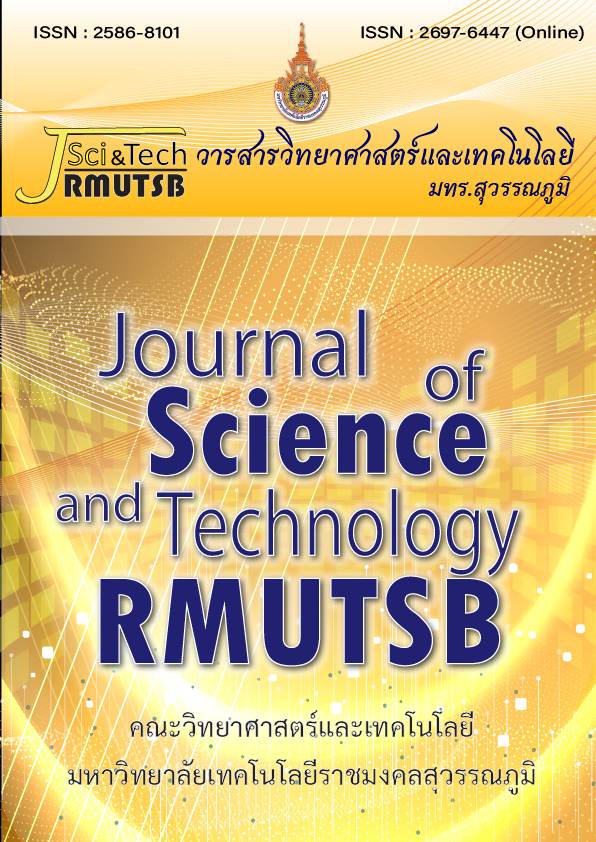พัฒนาเกณฑ์ปกติสมรรถภาพทางกายที่สัมพันธ์กับสุขภาพของนักศึกษา มหาวิทยาลัยเทคโนโลยีราชมงคลสุวรรณภูมิ
คำสำคัญ:
Healthy Physical Fitness Norms, Health-Related Physical Fitness , Undergraduate studentsบทคัดย่อ
The objective of this research was to study and establish physical fitness norms for the health of male and female students of Rajamangala University of Technology Suvarnabhumi. A multi-stage sample of 302 people, 132 males and 170 females was sampled. The Office of Sports Science, Department of Physical Education, Ministry of Tourism and Sports consists of 5 items: Body Mass Index, sit and reach, hand grip, 60 seconds chair stand and 3 minutes step up and down. Number and percentage Establishing physical fitness norms in each report using T scores BMI test items are divided into 5 levels (thin or underweight, Proportionate body Overweight or Grade 1 obesity Obesity or Grade 2 obesity Dangerous obesity or Grade 3 obesity) The physical test determined the level of physical fitness for each of the 4 health items divided into 5 levels: Very Good, Good, Moderate, Low and Very Low.
Female students (56.3%) had an average age of 19 years, with a BMI of mostly proportional body mass (54.1%), and a sitting test with a good level of physical fitness (41.2%).The 60-second stand-up test had a low level of physical fitness (44.1%), while standing with the knees up and down for 3 minutes had a moderate level of physical fitness (45.9%). Male students (43.7%) had an average age of 19 years and had a proportional BMI (45.5%). The 60-second stand-and-sit test had moderate physical fitness levels (36.4 percent), while standing with the knees raised for 3 minutes had low physical fitness levels (41.7 percent).
เอกสารอ้างอิง
Dalvandi, A., Rohani, C., Mosallanejad, Z., & Hesamzadeh, A. (2015). Meaning of wellbeing among Iranian women A phenomenological descriptive approach. Iranian Journal of Nursing and Midwifery Research, 20(1), 17-24.
Krejcie, R.V., & D.W. Morgan. (1970). “Determining Sample Size for Research Activities”. Educational and Psychological Measurement. 30(3) : 607 – 610.
กรมพลศึกษา. (2562). แบบทดสอบและเกณฑ์สมรรถภาพทางกาย ของประชาชน อายุ 19-59 ปี. สืบค้น 1 เมษายน 2563. จาก https://www.dpe.go.th/manual-preview-411291791794
เกษมสันต์ พานิชเจริญ และคณะ. สมรรถภาพทางกายของนิสิตสาขาวิชาพลศึกษา คณะศึกษาศาสตร์ มหาวิทยาลัยบูรพา ปีการศึกษา 2562. วารสารการศึกษาและพัฒนาสังคม ปีที่ 15 ฉบับที่ 2 เดือนมกราคม-มิถุนายน พ.ศ. 2563 หน้า 1-9.
เจริญ กระบวนรัตน์. (2556). ประโยชน์และคุณค่าของการออกกำลังกายที่มีต่อร่างกาย. วารสารสุขศึกษา
พลศึกษา และสันทนาการ, 39(2), 13-14.
ปัณรสี เอี่ยมสะอาด และคณะ. การศึกษาสมรรถภาพทางกายเพื่อสุขภาพของนักศึกษา มหาวิทยาลัยราชภัฏนครปฐม.
วารสารบัณฑิตศึกษา ปีที่ 10 ฉบับที่ 46 มกราคม –กุมภาพันธ์ 2556 หน้า 61-69.
วิริยา บุญชัย. (2529). การทดสอบและวัดผลทางพลศึกษา. พิมพ์ครั้งที่ 2. กรุงเทพฯ: ไทยวัฒนาพานิช.
สำนักงานคณะกรรมการพัฒนาการเศรษฐกิจและสังคมแห่งชาติ. (2545). ความอยู่ดีมีสุขของคนไทย. วารสารเศรษฐกิจและสังคม ปีที่ 39 ฉบับที่ 1เดือนมกราคม –กุมภาพันธ์.
สุพิตร สมาหิโต. (2549). การสร้างแบบทดสอบและเกณฑมาตรฐานสมรรถภาพทางกายที่สัมพันธ์กับสุขภาพสำหรับ เด็กไทย อายุ 7 - 18 ปี. นนทบุรี: พี เอส ปริ้นท์
สมนึก ภัททิยธนี. (2544). การวัดผลการศึกษา. มหาสารคาม : ภาควิชาวิจัยและพัฒนาการศึกษา
คณะศึกษาศาสตร์ มหาวิทยาลัยมหาสารคาม.
สุรีพร อนุศาสนนันท์. (2554) การพัฒนาแบบสอบผลสัมฤทธิ์ทางการเรียนวิชาการวัดผลและประเมินผลในชั้นเรียนโดยกำหนดคะแนนมาตรฐานด้วยวิธีบุ๊คมาร์ค. คณะศึกษาศาสตร์ มหาวิทยาลัยบูรพา:ชลบุรี. DOI : สืบค้นจากhttps://doi.nrct.go.th/ListDoi/listDetail?Resolve_DOI=10.14457/BUU.res.2011.45
อนันต์ ศรีโสภา. (2525). การวัดผลการศึกษา. กรุงเทพฯ:ไทยวัฒนาพานิช.
ดาวน์โหลด
เผยแพร่แล้ว
รูปแบบการอ้างอิง
ฉบับ
ประเภทบทความ
สัญญาอนุญาต
ลิขสิทธิ์ (c) 2024 วารสารวิทยาศาสตร์และเทคโนโลยี มทร.สุวรรณภูมิ

อนุญาตภายใต้เงื่อนไข Creative Commons Attribution-NonCommercial-NoDerivatives 4.0 International License.





